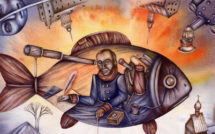

This is part of a roundtable on Marc Crépon’s Murderous Consent: On the Accommodation of Violent Death.
The idea of translating Murderous Consent had its immediate source in the simple, uninteresting fact that my research interests and Marc Crépon’s overlap. We both explore the fictitious origins of political identity. The world as a patchwork of nations, each endowed with one of five colors on a classroom globe, has been elevated to universal common sense after a mere century and a half of social construction. The classroom globe organizes humanity more or less linguistically and culturally into compact territorial spaces. The construction of this commonsense organization has its roots in a mythical vision that emerged only about two centuries ago in western Europe (or, in the terms I utilize, along the Rhineland frontier). It became the norm of power politics following World War I, when Europe’s boundaries were re-drawn in application of Woodrow Wilson’s more or less novel ideal of “national self-determination.” That construction was extended to the rest of the world following decolonization in the 1960s and the collapse of the Soviet empire in the 1990s. No matter how uncontestably “normal” the myth may seem today, it is, as myths go, surprisingly revolutionary.
Marc Crépon’s early work focuses on this and other myths that posit the existence of univocal and deep-rooted claims to “belonging,” of claims to identitarian essence. His first book, Les geographies de l’esprit, looked at the formulation of the idea of nationhood by eighteenth century philosophers, Leibniz, Hegel, Buffon, Voltaire, Kant, Fichte, and Humboldt. He wrote subsequently on Herder and published several works on language as the marker of belonging and exclusion. He also wrote on otherness as constitutive of the European project, and more recently he has explored literary and philosophical efforts to subvert the mythical conditions of identitarian violence.
From his student days, Crépon has admitted to bewilderment at the power of myths of belonging to condition violence, to inhibit solidarity with human communities under stress, and, we might add in our day, to retard efforts to mount a global response to the perils that threaten humanity’s survival as a species. That threat is no longer the hyperbolic preserve of science fiction. Climate change, species die-off, the development of dangerous and toxic technologies, rapid microbial adaptation to antibiotics and other medicines, all present humanity with dangers that the sovereign “nation”-state—the guarantor of identity—cannot address. Even international organization may prove inadequate to the task. International organization is conceptually impaired by the sub-textual legitimation that the very term inter-“national” confers on the myth of identity. The term “international” ratifies the particular while displacing the universal to the margins of the “good” and “progressive” ideal.
Politics invests considerable resources in preserving the “particular.” The particular—the bounded—is the site of political power. Politics’ claim that the particular deserves priority and that the global must wait (as a “practical” matter), goads us, as a species, to expose the myth’s conceptual and historical deficiencies. Crépon has responded to this challenge in a number of his writings, culminating in a series of works grouped under the title La Culture de la peur, which includes a forceful critique of Huntington’s concept of a “clash of civilizations,” followed by the three books dedicated to the notion of “murderous consent,” of which the book disscussed here is the prelude. It is followed by L’épreuve de la haine and The Vocation of Writing. Crépon’s efforts have earned him the reputation of public intellectual, despite, one might say, his serving as Chair of the Department of Philosophy at the École Normale Supérieure. He is frequently solicited to intervene in public fora and to address issues of pressing public concern.
It is true that dismantling myths of belonging presents no real challenge to the historian. All such myths labor to attribute some foundational homogeneity to collections of people that are very large and historically contingent. In the case of nationhood and nationalism, it is not difficult to show that the history is surprisingly short. The conceptual melding of language and territory at the heart of the concept of nationhood occurred in the mid-to-late eighteenth century. It made the transition from a concept reserved for poets and philosophers to something akin to common sense only in the late nineteenth century, when mass education required young provincials to learn the “national” language and absorb the “national” history (history as a university discipline is the offspring of nationhood). The first French army to speak French from general staff down through the lowest ranks was the army that marched to the trenches of World War I. History has no trouble in our day revealing the instability of our conceptual construction of “belonging,” its evolution over time, and, contemporaneously, the rapid acceleration and distortion of that evolution. The myth of the nation in Europe is durably haunted by forged epics like that of the putative third-century Caledonian bard Ossian, written by a young eighteenth century poet looking for work (James MacPherson, 1736-96), which in turn spawned imitations by Ossian’s literary enthusiasts who also began writing under assumed “barbarian” names, like “Rhingulph” and “Werdomar.” Both Goethe and Herder, and Hume the Scottish skeptic (but not skeptic enough), were Ossian aficionados.
Historical debunking has its limits, however. It stumbles on the objection that contemporary myths of belonging, despite their recent emergence, have nevertheless become normative. Efforts to debunk the myth are easily dismissed as irrelevant to contemporary politics, which is now irrevocably placed under the sign of nationhood. Debunking stumbles on identities that are so entrenched in the present that the debunker’s audience is generally confined to an inconsequential number of academic curmudgeons. As Crépon frequently points out, politics and the press that ratifies politics both work to assure that academic skepticism doesn’t spill over the academy’s frontiers and threaten the mobilizing and commercial force of a simple, effective, and profitable idea. Crépon’s chapter on Karl Kraus is a breath of fresh air for all who bemoan the cynical willingness of today’s press to ratify political crusades that it claims to denounce. Journalistic representations of “white nationalism,” for example—a nonsensical category if there ever was one (history’s most destructive wars have generally pitted “whites” against other “whites”)—draw attention to its rise without ever questioning its reality.
What Crépon invites us to discover in Kraus’s satires is a kind of deconstruction of political boundaries through irony. Crépon complements Kraus’s efforts with the Derridean observation that all boundaries, and the categories whose integrity they claim to reveal, struggle to preserve themselves in contexts that enable and thus invite multiple interpretations. If the boundary is not ontological—and it almost always is not—then the revelation of its inner inconsistencies and contradictions can be mobilized to expose the fragility of mythical constructions that justify non-assistance, non-solidarity, and, in our day, non-cooperation in times of global emergency.
One of the compelling features of Crépon’s book is its use of deconstruction to explore the ideal of justice as impossible possibility. He stays close to Derrida in this regard. It is true that deconstruction, without moral and political orientation, can sometimes resemble a parlor game of no real importance. But oriented by the pursuit of an unattainable, hyperbolic justice as a kind of pole star, Crépon is able to nurture an unusual alliance between deconstruction and the phenomenology that deconstruction was born to critique. His book The Thought of Death and the Memory of War had already provided a “re-match” of the encounter between Derrida and Levinas. Crépon shares Derrida’s skepticism regarding Levinas’ phenomenological forays into the concept of the Other and otherness, and the logocentrism that this concept exhibits. He parses Derrida’s thought of mourning as the structural given of otherness, and affirms the spectrality of the other. But when he turns to questions of moral and political responsibility, he confers on the other the power to advance a non-deconstructible, unproblematically phenomenal event, which is the utterance of the words, “help me.” Crépon prefers to impute to the face of the other, not the words “don’t kill me,” which are expressive, Levinas says, of the originarily ethical structure of being-in-the-world, but, rather, the other’s “actual words,” “help me,” which we hear again and again, as a concretely phenomenal given. The claim is too immediate and primitive to invite deconstruction. The cry does, however, invite us to deconstruct all the arguments that work to justify not responding to it. For me this is the single most interesting claim the book makes, and one with potent implications. It enables Crépon to posit a categorical definition of “we” that is, first, irrefutable, and second, politically provocative and challenging. It is the category “we mortals,” the only categorization of humans that potentially resists deconstruction and yet is meaningfully, and perhaps urgently concrete. We will all be, at some point in our lives, the other who cries “help me.” As a category it provides a perspective from which to observe and judge all politics and all moral comportments. It exhorts us to imagine a form of territorial political organization that is, and can only be, global in scope. It justifies only the cosmopolis, not the traditional cosmopolis of the well-healed globetrotter, but that of the victim who cries “help me”—whether victim of circumstances such as natural disasters, or political oppression.
The idea of a cosmopolis, as impossible possibility, gives sense and orientation, sens in French, to political action. Crépon invites us to imagine an ethically motivated ethi-cosmo-politics that deconstructs boundaries, ideologies, and constructed identities in order to attend to the suffering and mourn the dead. His invitation is not simple idealism. The challenges that humanity now confronts—climate change, limits to growth, migration, species die-off—are all urgent and global in scope. Policy-making within the common sense of national sovereignty and increasingly, it would appear, even within the international organization of sovereign nations, is increasingly helpless. The question then becomes how we might free ourselves from the hold of concepts that are an obstacle to action. The answer, Crépon argues, is in the non-deconstructible cries for help of humans under stress, and in our ensuing powerlessness to justify inaction with anything other than fabricated and eminently deconstructible myths of belonging.
The emergence of ethicosmopolitics from the ethical challenge of human suffering may encounter resistance among political theorists, if only because ethics can sometimes be treated as a problem to solve rather than as a value providing orientation. Values divide; institutions unify. But political theories may be taking for granted conceptual entities that shouldn’t be: geographical, economic, and cultural boundaries that should be exposed as fictitious rather than treated as factual. The ethics of Crépon’s ethicosmopolitics contests the facticity of boundedness from the outset, and enrolls in its subversive enterprise the Derridean concept of artifactuality. In the world disclosed by the essential, irreducible phenomenality of the singularity’s plea for help, the only boundedness that matters in the end is that of our mortal finitude, and the community that matters is that of “we mortals.” That realization opens the imagination to new worlds of political possibility. It spikes the imagination in ways that facilitate rather than hinder efforts to think about our global challenges—challenges that have now become existential in scope. If we conceptualize the populations of south Asia who risk water shortages because of glacier melt-off, or the native populations of Amazonia who are robbed of the ecosystem that sustains their world, not as “foreigners” for whom we share no responsibility and no complicity, but as mortals whom we could mourn and whose call for help we should hear, then we see more readily that our attachment to boundaries is a threat to the sustainability of civilization as a whole and to the survival of the species.
But ethicosmopolitics can also run into obstacles of an affective character. In our world we simply don’t care much, and are not encouraged to care much, about people who live “far away,” even when the harm they endure has its source in the same global challenges that we all face (in Murderous Consent this kind of challenge is represented by nuclear proliferation). Crépon therefore innovates by interweaving philosophical (deconstructive and phenomenological) analysis with literary narratives that bring to life the emotions endured by humanity under stress. Affective reactions to such stress provoke responses that effectively contest and transcend the boundaries that shelter the anesthetic environment that power requires in order to assert its rule and privilege, and that power requires to generate and cultivate its own affective underpinnings. Crépon recalls the comic irony with which Karl Kraus treated assertions of difference, especially moral difference, that national boundaries between self and other try to delineate. He also explores Vasily Grossman’s notion of “simple goodness” as the not-impossible possibility that transcends all boundaries and helps safeguard freedom from power. He pays particular attention to Kenzaburo Oe’s examination of shame, which is further developed and amplified by Günther Anders in his devastating critique of nuclear deterrence.
Irony, acts of simple goodness, and shame exemplify the act of rebellion against the injustice that is enabled by humanity’s indifference to the suffering of the ungrievable. Crépon devotes a chapter to Camus’ l’Homme révolté, whose ideas resonate with Crépon’s, but which Crépon hones and reinforces. Camus posits life as the one value that must be defended. He portrays it as the condition of possibility of all existential projection. But he does so from what Husserl might have described as the “natural attitude,” and so invites objections regarding the putative (culturally accidental) merits of the life that is being projected. Crépon turns Camus’ thinking around so as to ask if the existential projection itself might not affect our valuation of “life.” Crépon suggests we substitute for life the phenomenally concrete and urgent cry for help, the non-deconstructible expression of life as disclosed by torment. The cry for help in its bare phenomenality gives sense and orientation to rebellion in a way that is not undermined by culturally and ideologically specific aspirations or suspicions. The cry for help subverts identitarian values and the boundaries (territorial, economic, cultural) that are their condition of possibility. It is the rebellion of “we mortals.”
Michael Loriaux is Professor of Political Science at Northwestern University. He is the author of European Union and the Deconstruction of the Rhineland Frontier and other works relating to European unification.
Published on August 4, 2020.
Photo: Dreamscape with Time | A writer compose his book




